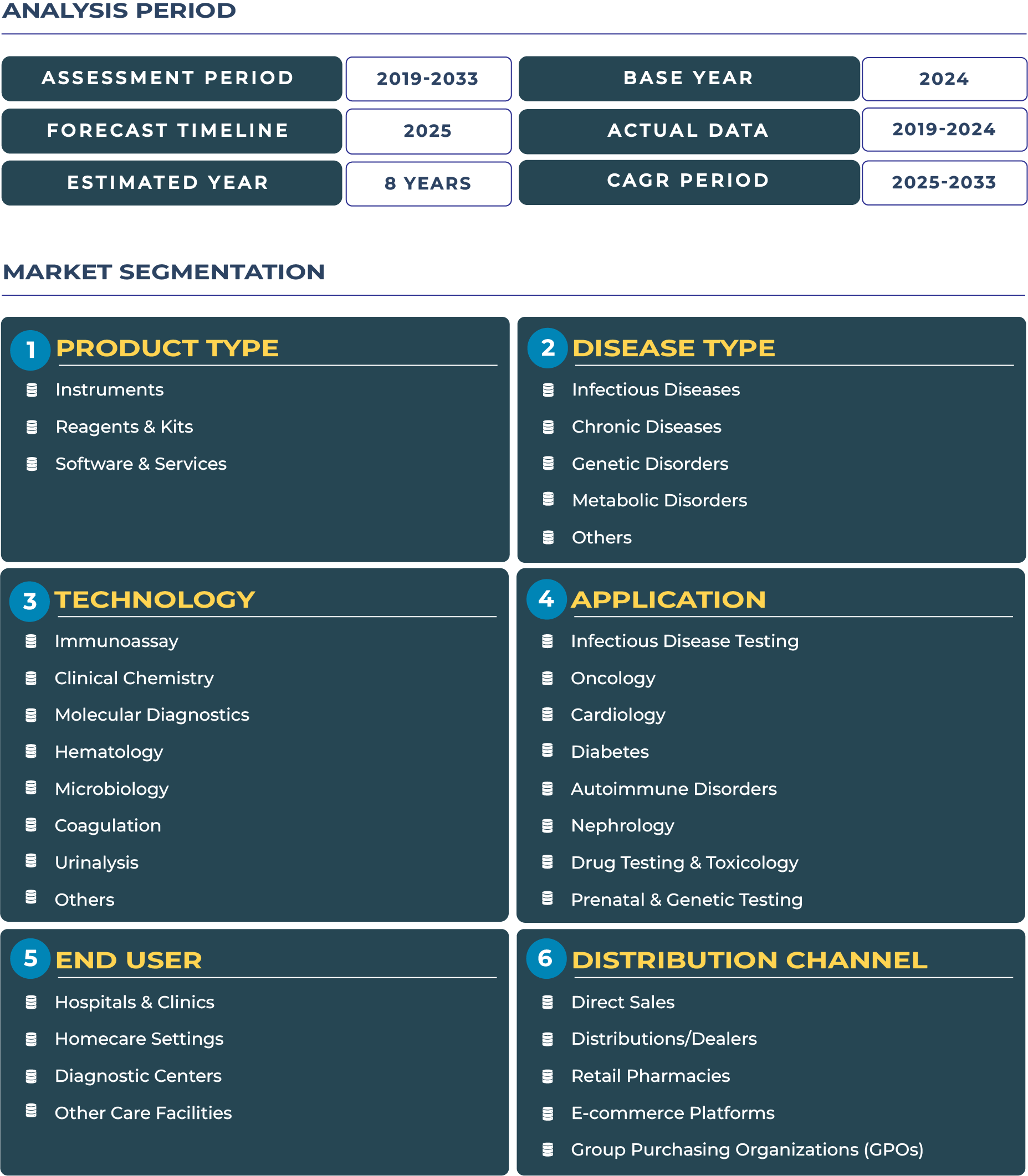Innovation-Driven Leadership Defining the North America In-Vitro Diagnostic Market
North America stands at the forefront of the In-vitro Diagnostic (IVD) market, leading global innovation through robust R&D, advanced clinical validation frameworks, and early adoption of precision diagnostic technologies. The region’s strong ecosystem, powered by U.S. Food and Drug Administration (FDA) regulatory strength, widespread clinical trial infrastructure, and collaborations between biotechnology firms and healthcare providers, continues to shape the global diagnostic landscape. With increasing chronic disease prevalence and growing demand for molecular, genetic, and point-of-care testing, the North America IVD industry is transforming the continuum of patient care.
The North America In-vitro Diagnostic Market is projected to reach USD 50.77 billion by 2033, rising from an estimated USD 36.69 billion in 2025. This growth trajectory is underpinned by the expansion of personalized medicine, advanced reagent systems, and integration of AI-driven diagnostics across major hospitals and laboratories. The region’s strong regulatory clarity, public–private partnerships, and leading players such as Abbott Laboratories position it as the global epicenter for diagnostic innovation.
Strategic Drivers Fueling Market Expansion in North America
The aging population and chronic disease prevalence remain among the strongest growth catalysts for the IVD industry in North America. With a rapidly growing geriatric demographic, the demand for early and accurate testing in oncology, cardiovascular, and infectious diseases continues to climb. The surge in point-of-care and molecular diagnostics, supported by hospitals and independent laboratories, has accelerated adoption rates. Additionally, rising healthcare expenditure and the proliferation of private ambulatory surgical centers (ASCs) are enabling the shift toward preventive testing and personalized care models.
Technological advancement is another powerful driver. Increasing automation of diagnostic instruments, integration of high-throughput systems, and deployment of AI-based image analysis platforms are enhancing operational efficiency and diagnostic accuracy. Moreover, clinical data interoperability enabled by cloud-based diagnostic software solutions is driving system-wide modernization. The strategic alignment of policy frameworks under agencies such as the Centers for Disease Control and Prevention (CDC) further reinforces the regional emphasis on diagnostic readiness and laboratory modernization.
Constraints and Structural Challenges Impacting Market Momentum
Despite its strength, the North American IVD landscape faces reimbursement and regulatory complexities that can slow product deployment and innovation. Ongoing pricing pressures from payers and value-based reimbursement models have challenged diagnostic manufacturers to balance cost-effectiveness with high innovation standards. Regulatory recalibrations, especially under the evolving FDA guidance for Laboratory Developed Tests (LDTs), continue to redefine product approval cycles and market entry timing. Moreover, consolidation among hospitals and diagnostic chains has intensified vendor competition, leading to limited access for smaller and mid-sized diagnostic developers.
Supply chain disruptions, partially triggered by global geopolitical tensions and pandemic-era delays, have underscored the need for resilient reagent sourcing and localized production strategies. In addition, cybersecurity concerns in connected diagnostic platforms highlight the pressing need for robust data governance, especially as hospitals expand remote and cloud-based testing services. These factors collectively add layers of complexity to the North American IVD ecosystem.
Emerging Trends and High-Value Opportunities Shaping the Market
The North American IVD market is undergoing a fundamental transformation driven by digitalization, miniaturization, and connectivity. Increasing adoption of at-home testing and subscription-based reagent delivery models are redefining the revenue structure of diagnostics. Cloud-integrated reporting platforms now allow clinicians to monitor patient outcomes in real time, reducing clinical turnaround time and improving decision accuracy. Moreover, data integration across hospital networks is accelerating through Health Information Exchange (HIE) initiatives, strengthening clinical collaboration.
Opportunities are expanding around data-driven diagnostic solutions and outcomes-based partnerships between manufacturers and healthcare providers. The growing interest in subscription-based software and analytics services, particularly in digital pathology and molecular diagnostics, opens new monetization channels. Additionally, the rapid expansion of regional ASCs and urgent care centers across urban and semi-urban areas presents untapped potential for reagent and instrument vendors targeting mid-tier healthcare operators.
Regional Market Analysis by Country
-
United States
The U.S. dominates the North America In-vitro Diagnostic Market, driven by its advanced healthcare infrastructure, extensive clinical testing networks, and continuous FDA approvals for next-generation diagnostic devices. The country’s robust demand for molecular, hematology, and immunoassay testing solidifies its market leadership.
-
Canada
Canada IVD sector benefits from strategic investments in laboratory modernization and national precision health programs. The government’s emphasis on healthcare digitization and AI integration in diagnostics positions the market for steady growth across both public and private testing facilities.
-
Mexico
Mexico is witnessing accelerated adoption of cost-effective diagnostic instruments and reagents in urban centers, supported by growing partnerships between international manufacturers and local distributors. Expanding healthcare access under national reforms continues to strengthen its IVD footprint.
Competitive Landscape: Value-Based Strategies Reshaping Market Dynamics
The competitive landscape of the North America IVD industry is characterized by innovation-driven rivalry among global and regional players. Companies such as Abbott Laboratories, Thermo Fisher Scientific, Danaher Corporation, and Becton, Dickinson and Company are actively expanding their product portfolios through mergers, acquisitions, and collaborations. In 2024, Abbott launched advanced molecular diagnostic systems with AI-enabled result interpretation, strengthening its leadership in infectious disease testing.
A strategic shift toward value-based contracts and outcome-linked pricing is reshaping procurement behavior. Manufacturers are increasingly offering bundled reagent–software packages and annual service models that align with clinical outcome goals. Furthermore, regional players are focusing on ASC-specific distribution partnerships to capture mid-scale demand. The competitive intensity, backed by rapid technological innovation, continues to reinforce North America’s position as the most dynamic and profitable IVD market globally.








